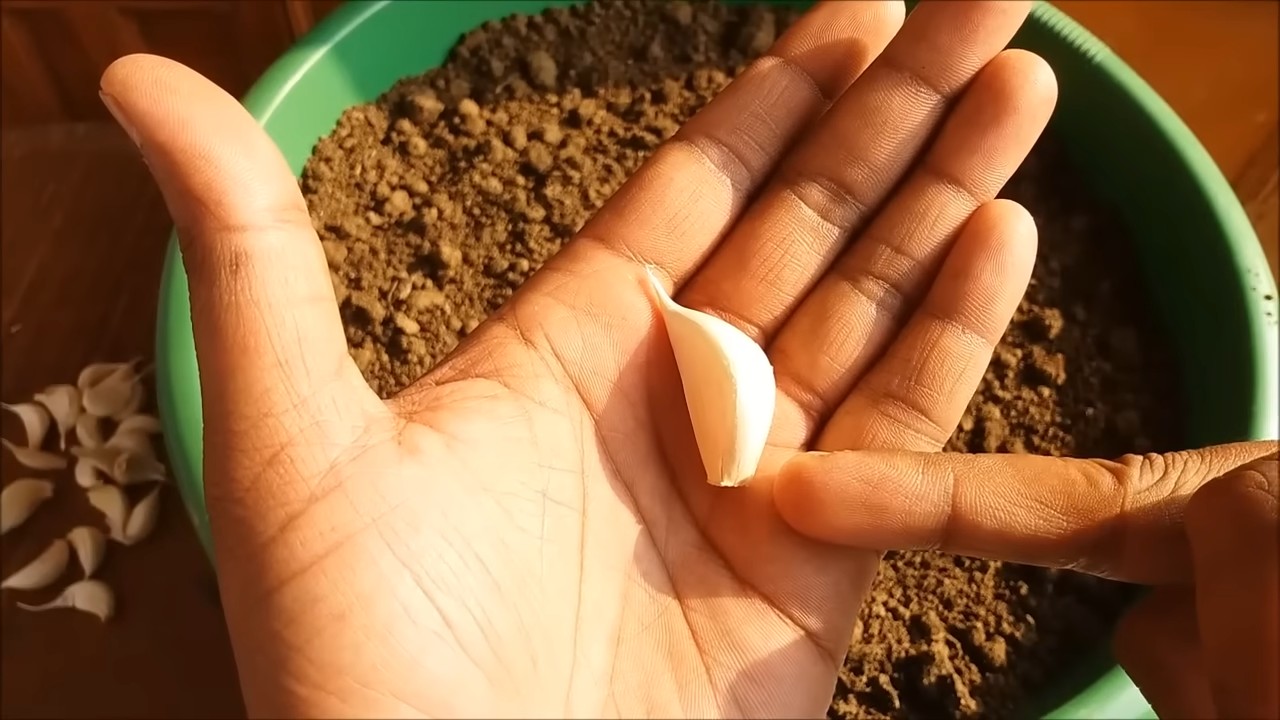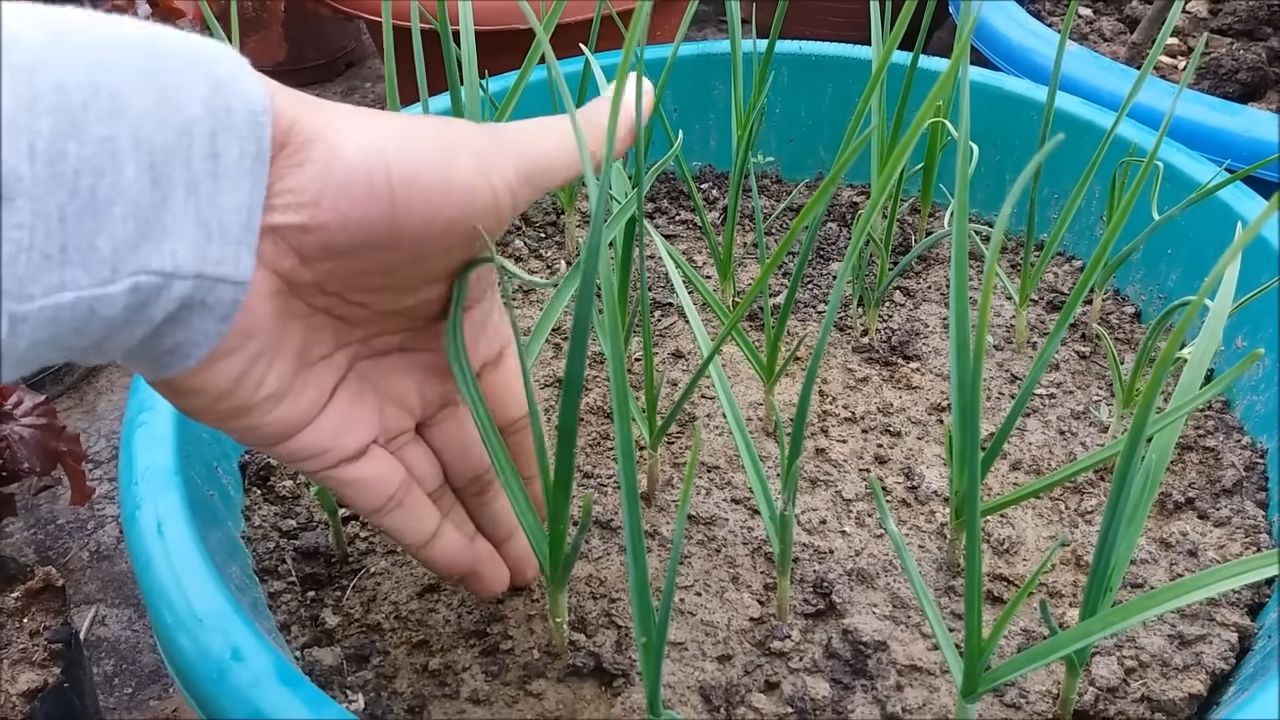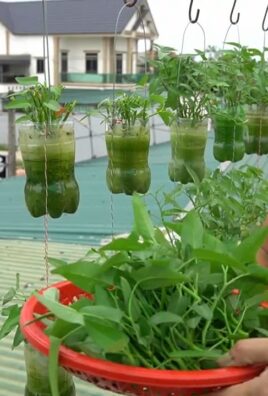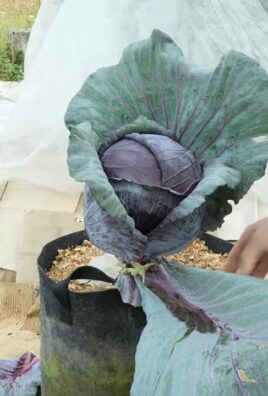Grow Garlic At Home: Imagine the satisfaction of snipping fresh, pungent garlic chives from your own backyard, ready to elevate your next culinary masterpiece. Forget those bland, store-bought cloves – we’re diving into the rewarding world of homegrown garlic! For centuries, garlic has been revered not only for its culinary uses but also for its medicinal properties. From ancient Egyptian tombs to medieval European gardens, garlic has been a staple, believed to ward off everything from vampires to the common cold.
But why should you bother learning how to grow garlic at home? Well, for starters, the flavor is simply unmatched. Freshly harvested garlic bursts with an intensity you won’t find in commercially grown varieties. Plus, you’ll have complete control over the growing process, ensuring your garlic is free from harmful pesticides and chemicals. In this article, I’m going to share some simple, yet effective DIY tricks and hacks that will have you harvesting a bountiful crop of garlic, even if you have limited space or gardening experience. Get ready to unleash your inner gardener and enjoy the delicious rewards of homegrown garlic!

Grow Your Own Garlic: A Beginner’s Guide to a Bountiful Harvest!
Hey there, fellow gardening enthusiasts! I’m so excited to share my experience with growing garlic at home. It’s surprisingly easy, incredibly rewarding, and the taste of homegrown garlic is simply unmatched. Forget those bland supermarket cloves – get ready for intense flavor and a sense of accomplishment! This guide will walk you through everything you need to know, from choosing the right garlic to harvesting your own delicious bulbs.
Choosing Your Garlic: The Foundation of Success
Before we get our hands dirty, let’s talk garlic selection. Not all garlic is created equal, and choosing the right variety for your climate is crucial.
* Hardneck vs. Softneck: This is the big one!
* Hardneck garlic is generally more cold-hardy and produces scapes (those curly flower stalks that are delicious!). They typically have a stronger, more complex flavor. Think of varieties like ‘German Extra Hardy,’ ‘Music,’ or ‘Chesnok Red.’
* Softneck garlic is better suited for warmer climates and is what you usually find braided. They store longer than hardneck varieties. ‘California Early’ and ‘Silverskin’ are popular choices.
* Source Matters: Don’t just grab garlic from the grocery store! It’s often treated to prevent sprouting. Instead, buy your garlic from a reputable seed supplier or local farmer. They’ll have varieties specifically suited for growing.
* Look for Healthy Bulbs: Choose firm, plump bulbs with no signs of mold, bruising, or sprouting. The bigger the clove, the bigger the bulb you’ll likely get!
Preparing for Planting: Timing is Everything!
Garlic needs a cold period (vernalization) to properly form bulbs. That means planting in the fall is key!
* Timing: In most regions, plant garlic 4-6 weeks before the ground freezes. This usually falls between late September and November. In warmer climates, you can plant in late fall or early winter.
* Location, Location, Location: Garlic loves sunshine! Choose a spot that gets at least 6 hours of direct sunlight per day.
* Soil Preparation: This is where the magic happens! Garlic needs well-draining soil that’s rich in organic matter.
* Amend the Soil: Dig in plenty of compost, aged manure, or other organic matter. This will improve drainage, fertility, and overall soil health.
* Check the pH: Garlic prefers a slightly acidic to neutral pH (around 6.0-7.0). You can test your soil with a kit from your local garden center.
* Loosen the Soil: Break up any compacted soil to allow for good root growth.
Planting Your Garlic: Getting Down and Dirty!
Now for the fun part!
1. Separate the Cloves: Gently separate the cloves from the bulb just before planting. Leave the papery skin on each clove intact.
2. Planting Depth: Plant the cloves about 2 inches deep (for smaller cloves) to 3 inches deep (for larger cloves).
3. Spacing: Space the cloves about 4-6 inches apart within rows, and space rows about 6-12 inches apart.
4. Orientation: Plant the cloves with the pointed end facing up (this is where the sprout will emerge) and the flat end facing down (where the roots will grow).
5. Cover with Soil: Gently cover the cloves with soil and lightly pat it down.
6. Water Well: Water the planting area thoroughly to settle the soil and encourage root growth.
7. Mulch, Mulch, Mulch!: Apply a thick layer of mulch (straw, shredded leaves, or wood chips) to help retain moisture, suppress weeds, and protect the garlic from extreme temperatures.
Caring for Your Garlic: Nurturing Your Crop
Once your garlic is planted, it’s time to provide some TLC.
* Watering: Garlic needs consistent moisture, especially during the spring when it’s actively growing. Water deeply whenever the top inch of soil feels dry. Avoid overwatering, which can lead to rot.
* Weeding: Keep the area around your garlic free of weeds. Weeds compete for nutrients and can harbor pests and diseases.
* Fertilizing: Garlic is a heavy feeder. In the spring, side-dress your garlic with a nitrogen-rich fertilizer, such as blood meal or fish emulsion. Follow the instructions on the fertilizer package.
* Scapes (Hardneck Garlic Only): If you’re growing hardneck garlic, you’ll notice curly flower stalks called scapes emerging in the spring. Cut these off when they start to curl. Removing the scapes encourages the plant to put more energy into bulb development. Don’t throw them away! Scapes are delicious sauteed, grilled, or made into pesto.
* Pest and Disease Control: Garlic is generally pest-resistant, but keep an eye out for common garden pests like aphids or onion thrips. Treat infestations with insecticidal soap or neem oil. Prevent fungal diseases by ensuring good air circulation and avoiding overwatering.
Harvesting Your Garlic: The Grand Finale!
The moment you’ve been waiting for!
* Timing: Garlic is typically ready to harvest in mid-summer, about 8-9 months after planting. A good indicator is when the bottom leaves start to turn yellow and brown. Don’t wait until all the leaves are brown, as the bulbs may start to deteriorate.
* Digging Up the Bulbs: Gently loosen the soil around the bulbs with a garden fork or trowel. Carefully lift the bulbs out of the ground, being careful not to bruise them.
* Cleaning: Brush off any excess soil from the bulbs, but don’t wash them.
* Curing: This is a crucial step for long-term storage.
* Hang or Lay Flat: Tie the garlic plants together in bundles or lay them flat on screens or racks in a well-ventilated, dry, and shady location.
* Curing Time: Cure the garlic for 2-4 weeks, or until the necks are dry and papery.
* Trimming: Once the garlic is cured, trim the roots and cut the stalks about 1-2 inches above the bulb.
* Storage: Store your cured garlic in a cool, dry, and dark place. Braided softneck garlic can be hung in a pantry or kitchen. Hardneck garlic typically doesn’t store as long as softneck garlic, so use it first.
Troubleshooting: Common Garlic Growing Problems
Even with the best planning, things can sometimes go wrong. Here are a few common problems and how to address them:
* Small Bulbs: This could be due to several factors, including poor soil, insufficient sunlight, lack of water, or competition from weeds. Make sure your garlic is getting enough of everything it needs!
* Rotting Bulbs: Overwatering or poorly draining soil can lead to bulb rot. Ensure good drainage and avoid overwatering.
* Pests and Diseases: Regularly inspect your garlic for pests and diseases. Treat infestations promptly with appropriate organic methods.
* Failure to Sprout: This could be due to planting garlic that was treated to prevent sprouting, planting too late, or planting in soil that is too cold or wet.
Enjoying Your Harvest: The Best Part!
Congratulations! You’ve successfully grown your own garlic! Now it’s time to enjoy the fruits (or rather, bulbs) of your labor. Use your homegrown garlic in all your favorite recipes. It’s amazing roasted, sauteed, added to soups and stews, or used to make garlic bread. You can also save some of your best bulbs to plant next year, continuing the cycle of homegrown goodness!
Growing garlic is a rewarding experience that connects you to the earth and provides you with a delicious and healthy ingredient. So, get out there, get your hands dirty, and enjoy the process! Happy gardening!

Conclusion
So, there you have it! Growing garlic at home is not only surprisingly simple, but it’s also incredibly rewarding. Imagine the satisfaction of harvesting your own plump, flavorful bulbs, knowing exactly where they came from and how they were grown. Forget those bland, imported cloves from the supermarket – with this DIY trick, you’ll be enjoying the robust, pungent taste of homegrown garlic in all your favorite dishes.
This isn’t just about saving a few dollars; it’s about connecting with your food, embracing a more sustainable lifestyle, and experiencing the joy of nurturing something from seed (or in this case, clove) to harvest. The flavor difference alone is reason enough to give it a try. Homegrown garlic boasts a depth and complexity that you simply can’t find in store-bought varieties. Think of the possibilities: garlic-infused olive oil, roasted garlic spread, or simply adding a freshly minced clove to your pasta sauce for an extra burst of flavor.
And the best part? You don’t need a sprawling garden to get started. A few pots on a sunny balcony or patio are all you need to embark on your garlic-growing adventure.
Consider these variations to personalize your growing experience:
* Experiment with different garlic varieties: There are hardneck and softneck varieties, each with its own unique flavor profile and growing requirements. Hardneck varieties are known for their intense flavor and the production of edible scapes (curly flower stalks), while softneck varieties are better suited for braiding and long-term storage.
* Companion planting: Garlic is a great companion plant for many vegetables, as it helps to deter pests. Try planting it near tomatoes, peppers, or strawberries to protect them from unwanted visitors.
* Garlic greens: Don’t forget about the garlic greens! These tender shoots can be harvested early in the growing season and used in salads, stir-fries, or as a garnish. They offer a milder garlic flavor and are a delicious way to enjoy your homegrown garlic before the bulbs are ready.
We truly believe that anyone can successfully grow garlic at home with a little patience and the right guidance. It’s a fantastic way to add fresh, flavorful ingredients to your cooking while also connecting with nature.
So, what are you waiting for? Grab a few cloves, find a sunny spot, and get planting! We’re confident that you’ll be amazed by the results. And once you’ve harvested your first crop, be sure to share your experience with us. We’d love to hear your tips, tricks, and favorite ways to use your homegrown garlic. Share your photos and stories in the comments below – let’s create a community of garlic-growing enthusiasts! We can’t wait to see what you create.
Frequently Asked Questions (FAQ)
Q: What kind of garlic should I plant?
A: The best type of garlic to plant depends on your climate and personal preference. Generally, hardneck varieties are better suited for colder climates, while softneck varieties thrive in warmer regions. Hardneck garlic produces scapes (edible flower stalks) and has a more complex flavor, while softneck garlic is easier to braid and store. Research which varieties are best suited for your specific area. Local nurseries or agricultural extension offices can provide valuable recommendations. Consider trying a few different varieties to see which one you like best!
Q: When is the best time to plant garlic?
A: The ideal time to plant garlic is in the fall, typically 4-6 weeks before the ground freezes. This allows the cloves to establish roots before winter sets in. In warmer climates, you can plant garlic in late fall or early winter. The key is to give the cloves enough time to develop roots but not enough time to sprout above ground before the cold weather arrives.
Q: How do I prepare the soil for planting garlic?
A: Garlic prefers well-drained soil that is rich in organic matter. Before planting, amend the soil with compost or well-rotted manure to improve its fertility and drainage. Ensure the soil is loose and free of rocks or debris. A slightly acidic to neutral soil pH (around 6.0 to 7.0) is ideal. You can test your soil pH with a home testing kit or by sending a sample to a local agricultural extension office.
Q: How deep and how far apart should I plant the garlic cloves?
A: Plant garlic cloves about 2 inches deep, with the pointed end facing up. Space the cloves about 6-8 inches apart in rows that are 12-18 inches apart. This spacing allows the garlic plants enough room to grow and develop healthy bulbs. If you’re planting in containers, use a pot that is at least 8 inches deep and wide enough to accommodate the number of cloves you want to plant.
Q: How much sunlight does garlic need?
A: Garlic needs at least 6 hours of direct sunlight per day to thrive. Choose a planting location that receives plenty of sunlight throughout the growing season. If you’re growing garlic indoors, place it near a sunny window or use grow lights to supplement the natural light.
Q: How often should I water garlic?
A: Water garlic regularly, especially during dry periods. Keep the soil consistently moist but not waterlogged. Avoid overwatering, as this can lead to bulb rot. Water deeply and less frequently, rather than shallowly and more often. Check the soil moisture regularly by sticking your finger into the soil. If the top inch feels dry, it’s time to water.
Q: How do I fertilize garlic?
A: Garlic benefits from regular fertilization, especially during the early stages of growth. Apply a balanced fertilizer (such as 10-10-10) in the spring, when the plants begin to actively grow. You can also side-dress with compost or well-rotted manure. Avoid over-fertilizing, as this can lead to excessive foliage growth and smaller bulbs.
Q: What are garlic scapes, and what do I do with them?
A: Garlic scapes are the curly flower stalks that grow from hardneck garlic varieties. They should be removed to encourage bulb development. Scapes are edible and have a mild garlic flavor. They can be used in stir-fries, pesto, or as a garnish. Harvesting scapes is a great way to enjoy your homegrown garlic before the bulbs are ready.
Q: How do I know when the garlic is ready to harvest?
A: Garlic is typically ready to harvest in mid-summer, when the lower leaves begin to turn yellow and brown. The tops of the plants may also start to fall over. To check if the bulbs are ready, carefully dig up a few plants and examine the bulbs. The bulbs should be plump and well-formed, with papery skins.
Q: How do I cure and store garlic?
A: After harvesting, cure the garlic by hanging it in a well-ventilated, dry place for 2-3 weeks. This allows the bulbs to dry out and develop their flavor. Once the garlic is cured, trim the roots and stems and store the bulbs in a cool, dry, and dark place. Properly cured and stored garlic can last for several months. Softneck garlic can be braided for easier storage.
Q: Can I grow garlic in containers?
A: Yes, you can absolutely grow garlic in containers! Choose a pot that is at least 8 inches deep and wide enough to accommodate the number of cloves you want to plant. Use a well-draining potting mix and ensure the container has drainage holes. Follow the same planting and care instructions as you would for growing garlic in the ground. Container-grown garlic may require more frequent watering and fertilization.
Q: What are some common pests and diseases that affect garlic?
A: Common pests that affect garlic include aphids, thrips, and nematodes. Diseases that can affect garlic include white rot, bulb rot, and downy mildew. Practice good garden hygiene to prevent pests and diseases. Rotate your crops regularly, avoid overwatering, and remove any infected plants promptly. Consider using organic pest control methods, such as insecticidal soap or neem oil.
Q: Can I save my own garlic cloves for planting next year?
A: Yes, you can save your own garlic cloves for planting next year. Choose the largest and healthiest bulbs from your harvest and set them aside for planting. Store the cloves in a cool, dry, and dark place until planting time. Using your own saved cloves is a great way to ensure a consistent supply of homegrown garlic year after year.





Leave a Comment